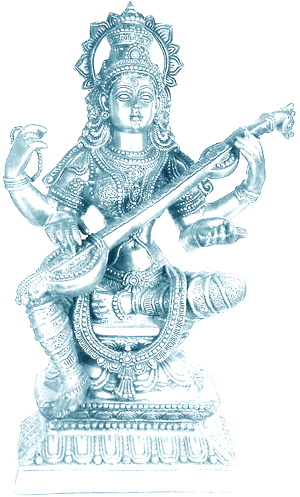
Saraswati
Saraswati is the Indian deity of wisdom and creativity. Her ancient lineage begins in the Vedas. She is known variously as a river, as the embodiment of creative and intellectual fertility, and as speech, the manifestation of knowledge. In the Vedas she is identified with the Saraswati River, a source of purification, fertility, and life. The river also stands for the "troubled waters" one must cross on the journey from the bondage of ignorance to the freedom of knowledge, insight and enlightenment, in which the sojourner is purified by submerging the old self and emerging reborn on the distant shore.
The Upanishads identify Saraswati, also known as Vac, as the goddess of speech. She is described as the union of power and intelligence, the flowing channel of eloquence through which Brahma the Creator created the world and manifested the four Vedas, whose spirit and meaning she represents. The Om mantra distills the original creative process, expressing ultimate reality in speech, and mirroring in sound the creation of the cosmos through vibration. Thus Saraswati is identified with artistic creativity, intellect, insight, poetry, literature, music and rational communication. As such, she is the goddess of jnana yoga, the yoga of analysis and scholarship.
As the personification of knowledge and artistic skill, Saraswati is usually depicted with four arms, seated on a white lotus and accompanied by her white swan. She holds a lute (with a swan’s head and tail in this statue), japa beads, a book and a water pot (not shown in this statue). The lotus symbolizes renunciation, the swan purity and perfection. The lute expresses devotion to the arts. The japa beads allude to the practical spiritual disciplines of yoga. The book symbolizes the intellect, scholarly research and literature. And the water pot alludes to the river as a site of sacred cleansing and purification. Saraswati is usually dressed in white, the color of peace, abstinence and spiritual illumination; and blue, the color of divinity and of the river. Her bearing is tranquil, forthright and natural.
Saraswati is variously described as the consort or feminine half of Brahma the Creator, and as the progenitor of Shiva, the Destroyer of illusion. She is a cultural goddess rather than a domestic or maternal one, to be found more often in libraries or academies than in the home. As a personality she is intellectual and scholarly; independent, argumentative, rebellious toward male authority; detached, reclusive, ascetic, and spiritual. She represents the character dispositions of purity, transcendence, serenity and austerity, the epitome of sattva-guna in Samkhya metaphysics. In Vedic ritual she presides over the evening chanting of the Gayatri Mantra, which reviews and consecrates the day now past.
“Saraswati lived perpetually in self-imposed exile. She focuses her calm, dispassionate gaze upon the past as pure experience. The capacity to recall without anger or resentment is Saraswati’s greatest gift to her children: the writers, musicians and creators of various art forms. All of them have fought with tradition, but their fight has been cerebral, not emotional. For without cutting away the umbilical cord, no innovative new beginning may ever be made, whether one is creating or procreating. This is the message of Saraswati. She remains a witness, a dispassionate historian. The unblemished ascetic goddess, to whom no temples are built and who offers nothing except knowledge: no institution, no protection, no riches.”*
----------------------------
*From: Nitin Kumar, “Lakshmi and Saraswati: Tales in
Mythology and Art,” www.exoticindia.com (December 2000)